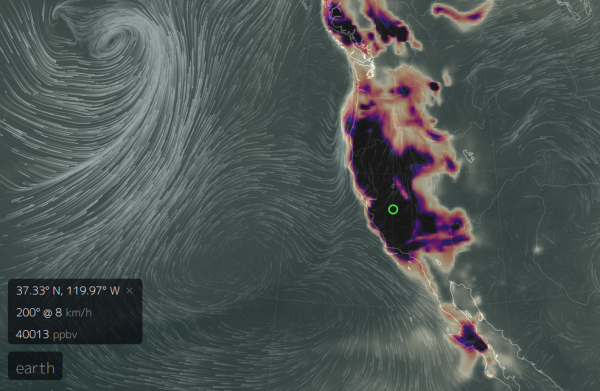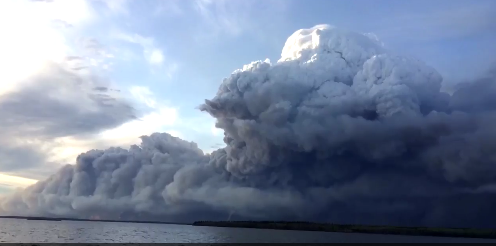Hint: it’s a glitch.
*****
On February 26, The Global Forecast System model recorded an (unconfirmed) intense and wide-ranging carbon monoxide (CO) spike over the US West Coast. A region stretching from British Columbia, through Washington and Oregon, and on over most of California experienced CO readings ranging from about 5,000 parts per billion over the mountains of Southwestern Canada to as high as 40,000 parts per billion over Southern California. Very high peak readings appear to have occurred from Northern California near Eureka and along a line south and eastward over much of Central California to an extreme peak zone just north and west of Los Angeles near Palmdale.

(Very large [unconfirmed] CO spike over Western North America near major geological features on February 26, 2016. Image source: Earth Nullschool.)
For reference, these (unconfirmed) readings in the Nullschool Monitor were between 25 and 200 times above typical background CO levels of about 200 parts per billion and up to twelve times higher than second highest peak readings over polluted regions of China during the same period.
Major Spike Appeared in Just 3 Hours Starting February 25th
Human-based carbon monoxide sources are not generally known to produce spike readings so high and so wide-ranging over such a short interval of time. It would typically take a considerable emission many days to build up under a stagnant air mass. And, to this point, we do have a couple of dome high pressure systems which have tended to form near the California region over recent days. That said, surface winds in the region at 5-15 mph over most areas could hardly be considered stagnant. In addition, the current spike appears over an interval of three hours in the Nullschool data — going from zero coverage to covering all of California and parts of Nevada, Oregon, Washington and BC over that single short interval. It’s a very brief period for such a large and wide-ranging peak reading to appear so soon. One that would require a rather extraordinary pulse of pollution to produce the readings indicated on February 25-26.
Wildfires could produce a longer-term emissions spike under stagnant air as well. However, the wildfires now reported for California are small and isolated. They have flared, off and on, under drought conditions, for weeks without resulting in any significant large fire outbreaks or related major pollution spikes. So it appears unlikely that they are the source of the current burst. Other events related to the ongoing California drought may have had an impact (apparently, burning of desiccated trees from California’s orchards is currently quite widespread due to ongoing drought conditions remaining in place since 2012). However, such instances would have to have been very sudden and wide-ranging to produce the spike we saw on the 25th and 26th. Canadian wildfires — of which there have been very small and low intensity hotspot events recently (noteworthy due to their anomalous appearance out of season, if not for their intensity) — were very far from peak readings in California and did not produce even a moderate level of emissions (undetectable from the visible MODIS sensor).
The Earthquake Precursor Hypothesis
A final suspect for this preliminary observation (which has gotten much hype in social media circles over recent days) is geological. As the apparent spike in the monitor occurs over large fault lines, volcanoes, and above other active geological features along the US and Canadian West, it appears that activity within these features might have produced a brief if intense burp of this gas. Sulfur dioxide (SO2) readings — another geological gas — were also elevated in the monitor, with peak readings again appearing in Southwestern California.
It’s worth noting that no major US or Canadian geological organization has yet made any report on this particularly large CO spike. However, a piece of scientific research in Nature Asia, by K. S. Jayaraman notes that major CO and SO2 spikes may be an indication that future earthquake activity is on the way. According to Nature this kind of intense CO spike occurred prior to a 7.6 magnitude earthquake that shook Gujara in 2001 killing 20,000 people:
Singh said that CO levels were taken by an instrument onboard NASA’s Terra satellite — launched in 2009 — circling the earth in a polar orbit at a height of 705 km. The instrument measures CO concentrations at different heights and also computes the total amount of the gas in a vertical column of air above the earth surface.
Analysis of the satellite data showed a large peak in CO concentrations during January 19 and 20 — a week before the main earthquake event. On January 19, the total CO in the vertical column was also higher than usual. After the 26 January earthquake the concentration of the gas dropped.
According to the scientists, CO gas is forced out of the earth due to the build up of stress prior to the earthquake “influencing the hydrological regime around the epicentre.”
But before we tilt too far into alarmism on this particular possibility, we should consider the fact that the above paper appears to have had no confirmation or further comment in the sciences at this time. So the predictive usefulness of large CO spikes prior to earthquakes remains quite uncertain. And, as noted above, no major geological information outlet has made any warning or comment on earthquake risk.
Furthermore, there’s been no observed spike in earthquake activity along any of the major fault lines over the past week according to USGS observations. Contrary to what some irresponsible analysts have been implying, earthquake activity in the California region over the past 7 days was well within the normal range. At 161 over the past week, this small number is not indicative of any abnormal activity near the various active fault lines. Each year, Southern California alone experiences 10,000 earthquakes, most of which are so small that people don’t even feel them.
The US geological survey also maintains that:
There is no scientifically plausible way of predicting the occurrence of a particular earthquake. The USGS can and does make statements about earthquake rates, describing the places most likely to produce earthquakes in the long term. It is important to note that prediction, as people expect it, requires predicting the magnitude, timing, and location of the future earthquake, which is not currently possible.
Thus the apparent, current very large West Coast CO spike near major fault lines (and over regions suffering from what is now a very severe five-year drought) in this particular monitor remains a bit of a mystery.
Or is it all Just a Glitch?
Considering that all the wildfire and human potential sources for the CO pulse are unlikely to produce the spike in the Nullschool data, that we have no warning of potential impending geological activity from the major agencies, and that we have had no other reports from related agencies to confirm the spike, we should also consider that there may well be something wrong with the monitor. Artifacts can appear in the satellite model data and it’s not unheard of to get a spike reading due to other signals impacting how physical models interpret sensor data.

(Hourly carbon monoxide observations in Central San Bernardino do not match high surface CO measures recorded by the GEOS 5 model. Similar lower atmospheric readings come from station observations throughout Southern and Central California. Image source: California AMQD.)
To this point, lack of confirmation at ground reporting stations for high CO readings appearing in the GEOS 5 monitor increase the likelihood that these high peak readings were a glitch or an artifact in the physical data. A cursory view of local warnings shows no local CO air quality alerts for the areas indicated in the Nullschool data set (You can view a list of the local monitors here). Analysis of this data also shows much lower CO readings from these stations in the range of 400 to 1200 parts per billion — quite a bit lower than what the GEOS 5 monitor is showing.
So what we have is one model showing a very high CO spike, but none of the related ground monitors picking it up. Since there are hundreds of ground stations in this region, it seems quite a bit less likely that there is something wrong with each of the readings coming from these stations than from the GEOS 5 model itself.
This begs the question — was there some kind of false positive that confused GEOS 5? Was there some other signal that tripped the model to show such a high reading? But to these points, a general lack of overall confirmation from the hundreds of ground sensors scattered across the region seems to point to the likelihood that such elevated readings in the GEOS 5 monitor were a glitch, an artifact, or a false reading for this atmospheric level.
UPDATED: Final Confirmation — It’s A Model Algorithm Error
Dr. Gavin Schmidt, head of GISS NASA, has confirmed the glitch in his twitter feed which you can read here. He notes:
The Elevated Carbon Monoxide concentrations in the GEOS 5 products since February 25 of 2016 are incorrect. They are the consequence of unrealistic CO emissions computed by our biomass burning algorithm, which is based on satellite observation of fires… GMAO is working to correct this problem.
An excellent further explanation has been given by Bryan, a blogger over at Of Tech and Learning. His explanation is as follows:
“It’s pure coincidence that at MOPITT resumed data collection over western North America while its operating temperature was still stabilizing. Had the instrument’s temperature remained unstable for a few days, it would have looked like the whole globe was erupting gas. If MOPITT has started collecting data over the south pole, open ocean, or some other obscure location, I doubt anyone would have noticed and made a big fuss. MOPITT uses light collected in the infrared part of the spectrum. Based on Terra’s system status, the CO, CO2 and SO2 data collected by MOPITT on the 25th and 26th of February should be highly suspect. On the Earth map, the CO, CO2, and SO2 levels spike sometime between 1pm and 4pm Pacific time on Feb. 25th, which is between 2100 UTC on the 25th and 0000 UTC on the 26th. This is precisely during the time window when MOPITT’s operating temperature is still unstable.”
So a glitch does appear to be the cause of the current CO spike in the Nullschool data.
Links:
Earth Nullschool
AMQD Data
Dr Gavin Schmidt’s Twitter Feed
Active Fire Maps
Canadian Fire Maps
Cascadia Subduction Zone
The San Andreas Fault Line
Carbon Monoxide May Signal Earthquake
Paradise Burning
Copernicus Monitoring System
An Explanation of Carbon Monoxide Concentrations on US West Coast
Hat tip to Mike
Hat tip to MlParrish
Hat tip to WeHappyFew
Hat tip to Coopgeek
Hat tip to Greg
Hat tip to Bryan
Hat tip to FishOutofWater
Hat tip to Jim Benison



























